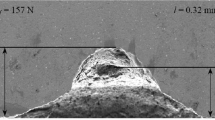Abstract
The fracture behavior of partially stabilized zirconia (PSZ) and silicon-nitride ceramics (Si3N4) is investigated under dynamic loading at elevated temperatures up to 1200°C using the caustic method combined with an ultra high-speed camera. The values of the dynamic fracture toughnessK Id and the crack-propagation fracture toughnessK ID are obtained, and it is shown that a dynamic effect on these values is observed in PSZ but not in Si3N4. The dynamic crack arrest toughnessK Ia is found to exist for PSZ.
Similar content being viewed by others
Abbreviations
- a :
-
crack length
- \(\dot a\) :
-
crack velocity
- C AE :
-
velocity of the visualized pattern based onAE-wave
- C R :
-
Rayleigh wave velocity
- C S :
-
distortional wave velocity
- c 0 :
-
optical constant of caustics
- D :
-
diameter of the caustic pattern
- E :
-
Young's modulus
- \(\dot K\) :
-
stress intensity factor rate
- K I :
-
stress intensity factor of Mode I
- K Ia :
-
dynamic crack arrest toughness
- K Ic :
-
static fracture toughness
- K ID :
-
crack-propagation fracture toughness
- K Id :
-
dynamic fracture toughness
- K Im :
-
stress intensity factor at\(\dot a\)≒0
- r 0 :
-
radius of the initial curve
- T :
-
testing temperature
- t :
-
thickness of specimen
- z 0 :
-
distance between the specimen and the image plane
- δ:
-
ratio ofD tor 0 in the case of λ=1
- λ:
-
magnification factor of the optical system
- μ:
-
Poisson's ratio
- ρ:
-
notch root radius
References
Sakata, M., Aoki, S., Kishimoto, K., Fujino, Y., andAkiba, T., “Measurement of Dynamic Fracture Toughness of Ceramic Material at Elevated Temperatures by Impact Test with Free End Bend Specimen,”J. Mat. Sci.,37 (419),910–915 (1998)(in Japanese).
Kobayashi, A.S., andYang, K.H., “Dynamic Stress Intensity Factors of Brittle Materials,”Adv. Fract. Res.,1,621–632 (1989).
Kalthoff, J.F., “Fracture Behavior Under High Rates of Loading,”Eng. Fract. Mech.,23 (1),289–298 (1986).
Zehnder, A.T. andRosakis, A.J., “Dynamic Fracture Initiation and Propagation in 4340 Steel Under Impact Loading,”Int. J. Fract.,43,271–285 (1990).
Theocaris, P.S., “Ductile Branching Modes in Stable Propagating Cracks: An Experimental Study,”Eng. Fract. Mech.,36 (3),477–493 (1990).
Shimizu, K. andShimada, H., “Determination of Stress Intensity Factor by the Method of Caustics,”J. Japanese Soc. Nondestructive Inspection,27 (7),399–406 (1978)(in Japanese).
Shimizu, K., Takahashi, S., andShimada, H., “Some Propositions on Caustics and an Application to the Biaxial-fracture Problem,” EXPERIMENTAL MECHANICS,25 (2),154–160 (1985).
Shimizu, K., Otani, K., and Takahashi, S., “On the Strength Evaluation of the Zirconium Ceramic Plates by the Direct Surface Reflection Caustics,” Proc. 9th Int. Conf. Exp. Mech., Copenhagen, Denmark, 1462–1471 (1990).
Nishioka, T. andKittaka, H., “A Theory of Caustics for Mixed-mode Fast Running Cracks,”Eng. Fract. Mech.,36 (6),987–998 (1990).
Rosakis, A.J. andRavi-Chandar, K., “On Crack-tip Stress State: An Experimental Evaluation of Three-dimensional Effects,”Int. J. Solids Struct.,22 (2),121–134 (1986).
Yang, W. andFreund, L.B., “Transverse Shear Effects for Through-cracks in an Elastic Plate,”Int. J. Solids Struct.,21 (9),977–994 (1985).
Shimada, H. andSasaki, T., “Determination of the Stress Intensity Factor by the Method of Surface Reflected Caustics,”Trans. Japan. Soc. Mech. Eng.,49 (441),579–588A (1983)(in Japanese).
Fourney, W.L. andRossmanith, H.P., “Crack Tip Position and Speed as Determined from Rayleigh Wave Patterns,”Mech. Res. Communications,7 (5),277–281 (1980).
Shockey, D.A., Kalthoff, J.F., Klemm, W., andWinkler, S., “Simultaneous Measurements of Stress Intensity and Toughness for Fast-running Cracks in Stell,” EXPERIMENTAL MECHANICS,23 (2),140–145 (1983).
Dally, J.W., “Dynamic Photoelastic Studies of Fracture,” EXPERIMENTAL MECHANICS,19 (10),349–361 (1979).
Author information
Authors and Affiliations
Rights and permissions
About this article
Cite this article
Suetsugu, M., Shimizu, K. & Takahashi, S. Dynamic fracture behavior of ceramics at elevated temperatures by caustics. Experimental Mechanics 38, 1–7 (1998). https://doi.org/10.1007/BF02321259
Issue Date:
DOI: https://doi.org/10.1007/BF02321259




